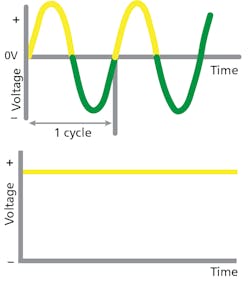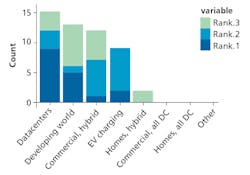Many buildings are switching from alternating current (AC) to direct current (DC) power distribution. But is DC power right for every commercial, industrial, and multifamily project? What is the expected capital investment and ROI?
According to a 2018 study1, the top three benefits of DC power are energy and operational savings from eliminating AC to DC power conversions; increased reliability of systems that use DC power, such as LED lighting, HVAC, and digital devices like computers and smart appliances; and efficient storage in batteries, which use DC power.
The study’s authors note that adapting to and standardizing DC power distribution in buildings will take time. They predict the uptake will be slow in part because industry professionals — engineers, electricians, inspectors, and regulators — are unfamiliar with DC power, its benefits, its implementation, and the relevant standards.
DC power primer
In the U.S., most power grids have distributed AC power since Westinghouse and Nikola Tesla won the War of the Currents in the late 1800s.
AC power was chosen to power the modern world largely because its infrastructure was more cost effective2 than DC power. Voltages could be easily stepped down and, at the time, many devices used AC electricity.
Today, things have changed. In fact, Brian Patterson of EMerge Alliance writes that more than 70% of the world’s generated AC power needs to be converted into DC power for use in electronic devices and systems3. A lot of electricity is wasted in this inefficient conversion.
Transmission line status
Most transmission lines distribute high-voltage AC power, but with technological advancements, hundreds of transmission systems worldwide are now transmitting high-voltage DC power (HVDC)4. These lines have lower power losses — 2 to 3% in HVDC lines as compared to 10% in AC power transmission5. Still, HVDC transmission systems have room for improvement because their grids must convert the power at rectifier stations from DC to AC for distribution to buildings. That is, although DC power is being transmitted over long distances, our DC-powered devices are still receiving and converting AC power — unless their buildings distribute DC power locally.
DC power can be distributed locally throughout a building in several ways. Power over Ethernet (PoE) is one approach. Another involves the installation of a centralized AC-to-DC converter at a building’s electrical panel, eliminating the need for individual conversions at the load level. Spacr, a DC power distribution system created by the Canadian company Argentum Electronics, uses the latter approach; Argentum is this author’s employer.
DC power system benefits and ROI
Distributing DC power locally throughout a building offers four main benefits: energy savings and device reliability, futureproofing, operational savings, and safety.
Energy savings and device reliability. As mentioned earlier, about 70% of AC electricity generated worldwide is converted into DC electricity. These conversions are executed by a device’s drivers, which are connected to individual electrical loads, such as LED fixtures. California Energy Commission’s efficiency requirements state that AC to DC supplies with a load capacity of at least 45W must be at least 85% efficient6. However, AC to DC supplies with load capacities under 45W are exempted and thus waste, on average, 20% of the energy they consume during conversion7. Providing DC loads with DC power eliminates these losses and can result in buildingwide energy savings of approximately 5% to 20%8.
Inefficient drivers can also affect device reliability because wasted energy escapes in the form of heat, which can wear down the driver and shorten its operating life. In fact, an LED fixture that converts AC to DC power will last approximately 10,000 to 25,000 hours, but replacing its AC driver with a DC driver and distributing DC power to it will extend its operating life approximately fourfold9.
DC power systems help future-proof a building. Electric vehicle (EV) chargers represent an increasing power load in buildings. If these chargers are level 1 or 2 EV chargers, they supply AC power. But EV batteries need DC power, so the market for chargers that supply EVs with DC power is growing quickly, at an estimated CAGR of 29% from 2022 to 205010. In addition to being more efficient, DC chargers for EVs are safer and faster than AC chargers11.
With up to 130 million EVs on the road worldwide by 2030, according to a 2021 report by McKinsey and Co., “on-site commercial charging will need to become a standard building feature in the next 10 years to meet consumer demand12.”
As the concept of smart cities becomes more attainable, everyday appliances and loads will go digital, complete with integrated computers. These digital devices, with their reliance on semiconductors, require DC power.
DC power saves operational costs. Many electrical industry professionals believe that DC power will be beneficial and save energy, particularly in data centers and commercial buildings1.
In data centers where the AC power topology requires an isolation transformer (a device that changes voltage levels and isolates power for safety), a DC power system will save approximately 6.1% in energy costs13. Commercial buildings also save big — about $1.10 per square foot in annual electricity costs by switching to DC power distribution, according to Argentum Electronics’ savings calculator. Additional operational savings translates to an estimated ROI of two to five years after implementation.
DC power is safer than AC power. Coming into direct contact with either AC or DC electricity at high voltages is dangerous, but more so with AC electricity. Once an electrical current penetrates our skin, it can react with our nervous system, which is why an electrical shock hurts. Human skin has a higher impedance and resistance to DC current. AC electricity alternates at a frequency of 50 to 60 times per second, creating an electromagnetic field that can penetrate insulators — like our skin — more easily. DC electricity remains steady, without a pulsating electromagnetic field, rendering it less capable of penetration through the skin to damage the nervous system.
The National Electrical Code (NEC)14 has proposed a new electrical class for power systems that distribute up to approximately 450VDC electricity and is safe to touch. In this class, a computer monitors a circuit to detect any faults, including contact with human skin. If the computer detects any faults, it shuts power off immediately. DC power systems that can achieve this requirement, along with NEC’s other criteria, will be considered Class 4 power systems15.
Let’s talk money
The capital investment for a DC power distribution system for a commercial building depends on the system. Currently, only a handful of options are on the market. PoE systems require cabling, Ethernet switches, and injectors. Alternatives might use a wireless mesh network for data transfer instead of PoE cables, make one centralized AC-to-DC power conversion at the panel level, and not require devices to be PoE enabled.
In Glasgo’s 2018 study1, industry experts were asked to estimate the cost of outfitting a standard commercial office building with DC circuits in three different scenarios:
- Scenario A: An all-DC building under current market conditions.
- Scenario B: A hybrid system serving only lighting and computer workstations under current market conditions.
- Scenario C: An all-DC building to be constructed a decade later.
In Fig. 4, the red line is the cost for an equivalent AC system, which the researchers priced at $3.66/ft2 of floor area1.
In scenarios B and C, participants generally believed the cost of implementing DC power distribution would be similar to implementing AC power distribution. For scenario A, they estimated that outfitting an entire building with DC power distribution would be more expensive than an AC system.
Participants were instructed not to consider costs related to building-level power electronics, appliances, and controls, which the researcher believed would make the responses too variable.
Was the study accurate? Only time will tell. For now, owners have to compare the implementation costs of different DC power distribution system brands on a case-by-case basis. Shortly we’ll review cost considerations of specific DC systems, including PoE.
Obstacles to implementing DC power
Not all building systems are compatible with DC power. In this section we’ll cover factors to consider when researching and choosing a DC power distribution system.
When AC power became the building standard about a century ago, most loads, including incandescent lamps, toasters, and refrigerators, required AC electricity. But, with LED lights, variable speed HVAC motors, EV batteries, and today’s array of digital devices, many loads are shifting to DC electricity. In fact, up to 74% of loads in a building could require DC power, when considering EV chargers and HVAC equipment with DC motors16. This makes the majority of our devices compatible with DC electricity. However, compatibility with DC electricity and compatibility with a DC power distribution system are two different things.
A building’s compatibility with a DC power distribution system depends on the type of system deployed and the compatibility of individual loads with that system. For example, if the lighting system is compatible, then DC power distribution could be implemented just for the lighting system.
Some DC power distribution systems can plug directly into a typical electrical panel, convert AC power at the source, and distribute DC power throughout a building. This reduces the number of conversions down to one. In this scenario, owners must check whether their fixtures have removable drivers, which convert AC to DC electricity. Replacing that driver with an intelligent DC-DC driver will ensure that the correct voltage is provided.
PoE, another option, is safe and easy to install because it uses low-voltage DC power. If power requirements are not high, it can reduce the amount of cabling involved because power and data are transmitted over one cable type. However, it does require a few compatibility checks. PoE can only connect to building systems and devices that are designated as PoE systems.
PoE is currently limited to 90W per cable. Bundles of cable are often necessary to deliver appropriate power to each device, which can increase capital costs. For example, a lighting system in a 25,000-ft2 commercial office might need approximately 4000W, or 45 PoE cables bundled together. PoE cables also have limitations; they can run up to 100m before additional devices are required to extend their data and power reach.
PoE also requires Ethernet (CAT series) cables — which can be more expensive than typical electrical cables — as well as Ethernet switches or injectors17. All these things add complexity and cost to PoE systems.
The compatibility of individual loads with DC is another factor. For example, HVAC systems can benefit from DC power distribution only if they have a DC motor. Many HVAC systems have AC motors, but market demand for HVAC systems with DC motors has increased, largely because they are about 50% more efficient than those systems with AC motors.
Conclusion
Beyond its economic benefits, DC power is safer than AC power and helps futureproof buildings by providing electricity that is directly compatible with digital devices, LED lighting, and HVAC systems with DC motors. Although the number of DC power distribution systems on the market today is limited, they are offered by several brands, including Argentum Electronics, ARDA Power, and Voltserver. When choosing a DC power distribution system, you can also choose a PoE-based solution from vendors such as Cisco, Igor, and Focal Point Lights.
DC power distribution can save building owners and managers energy and operational costs by eliminating inefficient AC-to-DC conversions and by lengthening the operating life of DC powered devices. Depending on the type of DC power distribution system implemented in new or retrofit construction, the ROI can be two to five years.
Reach out to the author by connecting on LinkedIn.
REFERENCES
1. B. Glasgo et al., “Expert assessments on the future of direct current in buildings,” Environ Res Lett, 13, 074004 (2018).
2. E. Kelly, “Why AC power REALLY won the Current Wars,” Argentum Electronics blog (April 14, 2022).
3. B.T. Patterson, “DC: The Power to change buildings,” Construction Canada (Mar. 25, 2014).
4. List of HVDC projects via Wikipedia (updated July 14, 2022).
5. A. Berthou, “The benefits of high-voltage direct current (HVDC) power,” EE Power (Oct. 19, 2020).
6. D. Gunderson, “Stop the waste in your battery-charger conversion,” Electron Des (Mar. 12, 2008).
7. E. Kelly, “5 Reasons DC electricity should replace AC electricity in buildings,” Argentum Electronics blog (Mar. 3, 2022).
8. R. Price and M. Scerbo, “Direct current power systems can save energy, so building developers are getting a new incentive to incorporate them,” Alliance to Save Energy blog (Feb. 26, 2019).
9. E. Kelly, “Was the 100,000 hour LED light bulb false advertising?” Argentum Electronics blog (Sept. 10, 2021).
10. Report ID AA0421078, “Global electric vehicle charging station market,” Astute Analytica (May 6, 2022).
11. Electric Insights YouTube channel video, “What makes level 3/DC charging SO fast?” Argentum Electronics (July 7, 2022).
12. Z. Hoover et al., “How charging in buildings can power up the electric-vehicle industry,” McKinsey & Company (Jan. 5, 2021).
13. A.J. George and G. Ferrand, “Cost study of AC vs. DC data center power topologies based on system efficiency,” Eltek Power, Data Center Solutions white paper.
14. NFPA 70 National Electrical Code, National Fire Protection Association, current edition 2020.
15. E. Kelly, “Electricity You Can Safely Touch!? - Introducing Class 4 (CL4) Power Systems,” Argentum Electronics blog (April 26, 2022).
16. R. Price and M. Scerbo, “New LEED pilot credit encourages energy savings with DC power systems,” U.S. Green Building Council (Feb. 28, 2019).
17. “PoE Switch vs. PoE Injector: Which One to Choose?” Fiber Optical Networking (Nov. 21, 2017).
Get to know our expert
ERIN KELLY is the creative director and digital content researcher at Argentum Electronics. She has a new media degree from the University of Toronto and five years of experience in the communications field. Kelly has created digital content for dozens of clients through her own business, Story Unlocked, and loves technology, especially when it makes the world a better place.
Argentum Electronics provides DC power solutions such as those described in this article.
Extended online version; abridged version published in the October 2022 issue of LEDs Magazine.
For up-to-the-minute LED and SSL updates, follow us on Twitter. You’ll find curated content and commentary, as well as information on industry events, webcasts, and surveys on our LinkedIn page and our Facebook page.
Erin Kelly | Creative Director and Digital Content Researcher, Argentum Electronics
ERIN KELLY is the creative director and digital content researcher at Argentum Electronics. She has a new media degree from the University of Toronto and five years of experience in the communications field. Kelly has created digital content for dozens of clients through her own business, Story Unlocked, and loves technology, especially when it makes the world a better place.



![FIG. 4. Participants in the 2018 study by Glasgo et al.[1] were asked to estimate costs of outfitting a building with DC power under three different conditions: a) an all-DC building under current market conditions; b) a hybrid system serving only lighting and computer workstations under current market conditions; and c) an all-DC building 10 years in the future. FIG. 4. Participants in the 2018 study by Glasgo et al.[1] were asked to estimate costs of outfitting a building with DC power under three different conditions: a) an all-DC building under current market conditions; b) a hybrid system serving only lighting and computer workstations under current market conditions; and c) an all-DC building 10 years in the future.](https://img.ledsmagazine.com/files/base/ebm/leds/image/2022/10/2210LED_insF4.633f35ceaa346.png?auto=format,compress&fit=max&q=45&w=250&width=250)




